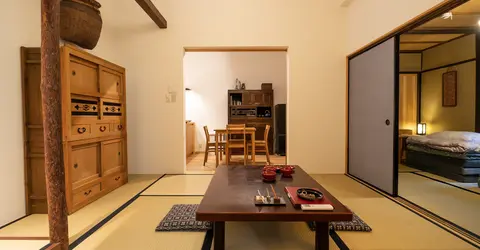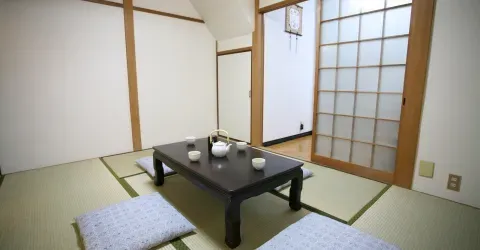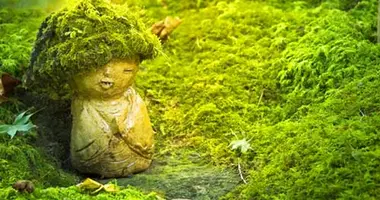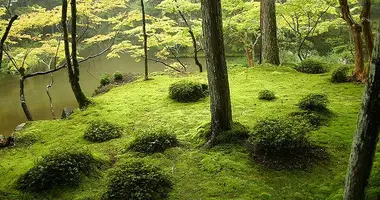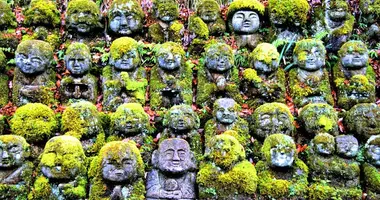Joruriji Temple Kyoto Prefecture
Joruriji Temple
Joruriji Temple 浄瑠璃寺
Joruriji Temple, like nearby Gansenji is located in southern Kyoto Prefecture near the prefectural border with Nara. The temple is, however, best accessed from Nara. The Jodo-shu (Pure Land sect) temple is also known as Kutaiji (九体寺) which refers to the nine statues in the main hall. In addition, the temple is famous for its autumn leaves and three story pagoda.  Pagoda at Joruriji, Kyoto Prefecture
Pagoda at Joruriji, Kyoto Prefecture
History
Joruriji Temple may date from the Nara Period of Japanese history, though its beginnings are not completely known. The wandering priest Gyoki (668–749) may have founded the temple, according to popular belief. Like Gansenji, the temple could also have been constructed according to the wishes of the Emperor Shomu (701-756), himself a devout Buddhist. However, the historical evidence points to a much later date of around 1047.  Heian Period garden pond at Joruriji Temple, Kyoto Prefecture
Heian Period garden pond at Joruriji Temple, Kyoto Prefecture
Temple Buildings
The temple has a vermilion three story pagoda and an impressive main hall (Amida-do). The hall contains a set of nine statues of the Amida Nyorai (Buddha of Boundless Light and Life) arranged in a row. The figures symbolize the nine stages of the Buddhist Nirvana - the release from the cycle of birth and death. The statues are protected by images of the Four Heavenly Kings (Shi-Tenno). The figures date from the Heian Period. They are also designated as national treasures. Amida Nyorai is a deity of particular importance to Jodo-shu (Pure Land) Buddhism. The pagoda contains a statue of the Buddha of medicine - Yakushi Nyorai.  Entrance to the temple
Entrance to the temple
Garden
The temple garden at Joruriji is one of only a few surviving Heian Period "Paradise Gardens" in Japan. The pond, which represents the sea separating birth and death, was dug in 1150 by priests from Kofukuji Temple in Nara. The island in the middle represents the earth and is connected to the land by a bridge of stone slabs. The Amido-do is on the western side of the pond and represents the Western Paradise. The pagoda, which contains an image of Yakushi Nyorai, the Buddha of healing and medicine, lies to the east of the pond and represents the Eastern Paradise. Both the main hall and pagoda were moved to Joruriji from previous locations in Kyoto during the 12th century. The garden also contains several ancient stone lanterns.  Joruriji, Kyoto Prefecture
Joruriji, Kyoto Prefecture
Access - Getting There
Joruriji Fudaba Nishi Kamo-cho Kizugawa-shi 619-1135 Tel: 0774 76 2390 Admission: 400 yen Hours: Daily 9 am to 5 pm; 10 am - 4 pm (December - February)  Information board The temple is best reached by hire car from Kyoto or Nara or bus from Nara city. To get to the temple take a Kizugawa Community Bus from Kamo Station on the JR Yamatoji Line to Joruriji bus stop. Alternatively, ride a Nara Kotsu Bus from JR Nara Station or Kintetsu Nara Station alighting at the Joruriji bus stop near Jyoruriji Temple. A 1-Day Ticket for the Kizugawa Community Bus can be purchased at JR Kamo Station and other places in Kizugawa city.
Information board The temple is best reached by hire car from Kyoto or Nara or bus from Nara city. To get to the temple take a Kizugawa Community Bus from Kamo Station on the JR Yamatoji Line to Joruriji bus stop. Alternatively, ride a Nara Kotsu Bus from JR Nara Station or Kintetsu Nara Station alighting at the Joruriji bus stop near Jyoruriji Temple. A 1-Day Ticket for the Kizugawa Community Bus can be purchased at JR Kamo Station and other places in Kizugawa city.
Nearby
A visit to Joruriji, if coming by bus from Nara is easily combined with seeing Gansenji Temple. A path, along which many historic stone Buddhist statutes, dating from the 12th and 13th centuries can be seen, connects the two temples.
